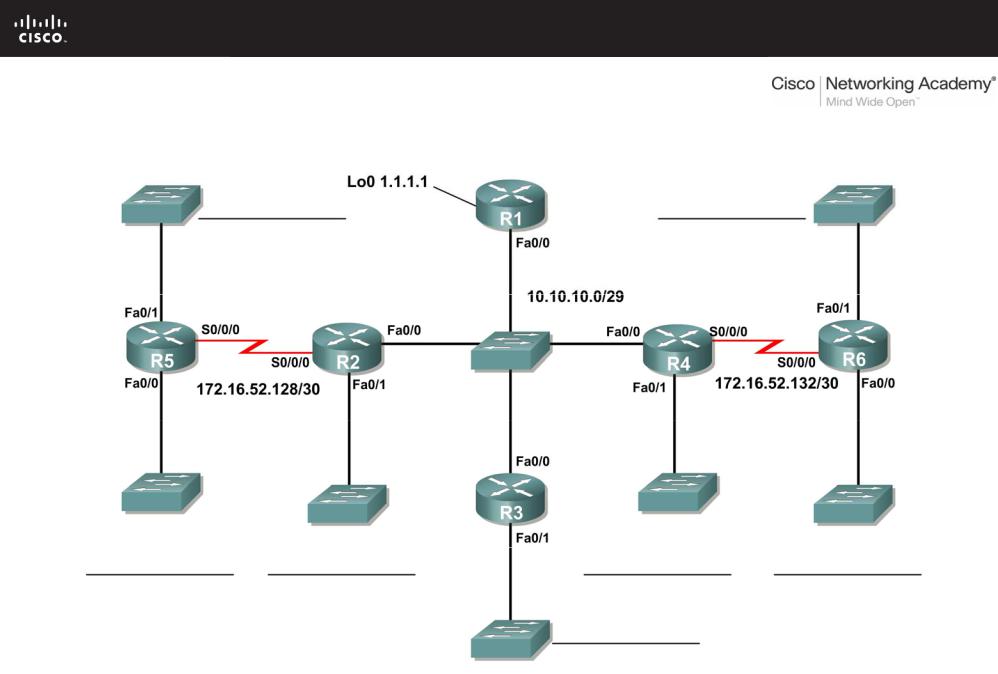
- •Lab 1.5.1: Cabling a Network and Basic Router Configuration
- •Lab 1.5.2: Basic Router Configuration
- •Lab 1.5.3: Challenge Router Configuration
- •1.6.1: Packet Tracer Skills Integration Challenge Activity
- •Lab 2.8.1: Basic Static Route Configuration
- •Lab 2.8.2: Challenge Static Route Configuration
- •Lab 2.8.3: Troubleshooting Static Routes
- •2.9.1: Packet Tracer Skills Integration Challenge Activity
- •Activity 3.5.2: Subnetting Scenario 1
- •Activity 3.5.3: Subnetting Scenario 2
- •Activity 3.5.4: Subnetting Scenario 3
- •3.6.1: Packet Tracer Skills Integration Challenge Activity
- •Lab 4.6.1: Routing Table Interpretation Lab
- •4.7.1: Packet Tracer Skills Integration Challenge Activity
- •Lab 5.6.1: Basic RIP Configuration
- •Lab 5.6.2: Challenge RIP Configuration
- •Lab 5.6.3: RIP Troubleshooting
- •5.7.1: Packet Tracer Skills Integration Challenge Activity
- •Activity 6.4.1: Basic VLSM Calculation and Addressing Design
- •Activity 6.4.2: Challenge VLSM Calculation and Addressing Design
- •Activity 6.4.3: Troubleshooting a VLSM Addressing Design
- •Activity 6.4.4: Basic Route Summarization
- •Activity 6.4.5: Challenge Route Summarization
- •Activity 6.4.6: Troubleshooting Route Summarization
- •6.5.1: Packet Tracer Skills Integration Challenge Activity
- •Lab 7.5.1: RIPv2 Basic Configuration Lab
- •Lab 7.5.2: RIPv2 Challenge Configuration Lab
- •Lab 7.5.3: RIPv2 Troubleshooting Lab
- •7.6.1: Packet Tracer Skills Integration Challenge Activity
- •Lab 8.4.1: Investigating the Routing Table Lookup Process
- •Lab 8.4.2: Show IP Route Challenge Lab
- •8.5.1: Packet Tracer Skills Integration Challenge Activity
- •Lab 9.6.1: Basic EIGRP Configuration Lab
- •Lab 9.6.2: Challenge EIGRP Configuration Lab
- •Lab 9.6.3: EIGRP Troubleshooting Lab
- •9.7.1: Packet Tracer Skills Integration Challenge Activity
- •10.3.1: Packet Tracer Skills Integration Challenge Activity
- •Lab 11.6.1: Basic OSPF Configuration Lab
- •Lab 11.6.2: Challenge OSPF Configuration Lab
- •Lab 11.6.3: OSPF Troubleshooting Lab
- •11.7.1: Packet Tracer Skills Integration Challenge Activity

11.7.1: Packet Tracer Skills Integration Challenge Activity
Topology Diagram
All contents are Copyright © 1992–2007 Cisco Systems, Inc. All rights reserved. This document is Cisco Public Information. |
Page 1 of 4 |

CCNA Exploration |
|
Routing Protocols and Concepts: OSPF |
11.7.1: Packet Tracer Skills Integration challenge Activity |
Addressing Table
|
Device |
|
Interface |
IP Address |
|
Subnet Mask |
|
|
|
|
|
|
|
|
|
|
R1 |
|
Fa0/0 |
10.10.10.1 |
|
255.255.255.248 |
|
|
|
|
|
|
|
|
|
|
|
Loopback0 |
1.1.1.1 |
|
255.255.255.255 |
|
|
|
|
|
|
|
|||
|
|
|
|
|
|
|
|
|
|
|
Fa0/0 |
10.10.10.2 |
|
255.255.255.248 |
|
|
R2 |
|
|
|
|
|
|
|
|
Fa0/1 |
|
|
|
|
|
|
|
|
|
|
|
|
|
|
|
|
|
|
|
|
|
|
|
|
S0/0/0 |
|
|
|
|
|
|
|
|
|
|
|
|
|
R3 |
|
Fa0/0 |
10.10.10.3 |
|
255.255.255.248 |
|
|
|
|
|
|
|
|
|
|
|
Fa0/1 |
|
|
|
|
|
|
|
|
|
|
|
|
|
|
|
|
|
|
|
|
|
|
|
|
Fa0/0 |
10.10.10.4 |
|
255.255.255.248 |
|
|
R4 |
|
|
|
|
|
|
|
|
Fa0/1 |
|
|
|
|
|
|
|
|
|
|
|
|
|
|
|
|
|
|
|
|
|
|
|
|
S0/0/0 |
172.16.52.133 |
|
255.255.255.252 |
|
|
|
|
|
|
|
|
|
|
|
|
Fa0/0 |
|
|
|
|
|
R5 |
|
|
|
|
|
|
|
|
Fa0/1 |
|
|
|
|
|
|
|
|
|
|
|
|
|
|
|
|
|
|
|
|
|
|
|
|
S0/0/0 |
172.16.52.129 |
|
255.255.255.252 |
|
|
|
|
|
|
|
|
|
|
|
|
Fa0/0 |
|
|
|
|
|
|
|
|
|
|
|
|
|
R6 |
|
Fa0/1 |
|
|
|
|
|
|
|
|
|
|
|
|
|
|
|
S0/0/0 |
172.16.52.134 |
|
255.255.255.252 |
|
|
|
|
|
|
|
|
|
Objectives
•Design and document an addressing scheme based on requirements.
•Apply a basic configuration to the devices.
•Configure a Routers Priority and RID's
•Configure OSPF routing
•Disable routing updates on appropriate interfaces.
•Verify full connectivity between all devices in the topology.
All contents are Copyright © 1992–2007 Cisco Systems, Inc. All rights reserved. This document is Cisco Public Information. |
Page 2 of 4 |

CCNA Exploration |
|
Routing Protocols and Concepts: OSPF |
11.7.1: Packet Tracer Skills Integration challenge Activity |
Task 1: Design and document an addressing scheme
Use the 172.16.0.0/16 to create an efficient addressing scheme that meets the following requirements:
|
Hostname |
|
|
Interface |
|
|
Number of Hosts |
|
|
|
|
|
|
|
|||
|
R2 |
|
Fa0/1 |
1000 |
|
|||
|
R3 |
|
Fa0/1 |
400 |
|
|||
|
R4 |
|
Fa0/1 |
120 |
|
|||
|
R5 |
|
Fa0/1 |
6000 |
|
|||
|
R5 |
|
Fa0/0 |
800 |
|
|||
|
R6 |
|
Fa0/1 |
2000 |
|
|||
|
R6 |
|
Fa0/0 |
500 |
|
|||
NOTE: Interface Fa0/0 has been preconfigured on R1,R2,R3, and R4.
Task 2: Apply a basic configuration.
Step 1: On each router use the following chart to complete the basic router configurations.
Console |
VTY |
Enable |
Clockrate (if |
Password |
Password |
Secret |
applicable) |
|
|
Password |
|
cisco |
cisco |
cisco |
56000 |
Task 3: Configure OSPF routing
Step 1: Configure OSPF routing on each Router.
Step 2: Verify that all Routes were learned.
Task 4: Fine-tuning OSPF
Step 1: Use the following guidelines to complete this task:
•R1 will never participate in a DR/BDR election.
•R2 will always become the DR
•R3 and R4 will both have the same priority of 100.
•R4 Should always become the BDR
NOTE: ALL PRIORITIES SHOULD BE SET ON FA0/0
Step 2: Force a DR/BDR election.
All contents are Copyright © 1992–2007 Cisco Systems, Inc. All rights reserved. This document is Cisco Public Information. |
Page 3 of 4 |

CCNA Exploration |
|
Routing Protocols and Concepts: OSPF |
11.7.1: Packet Tracer Skills Integration challenge Activity |
Task 5: Configure a Loopback
Step 1: On R1 configure a loopback with a 1.1.1.1/32 address.
Step 2: Create a Default route to the loopback
Step 3: Propagate the route within OSPF updates.
Task 6: View OSPF updates
Step 1: Enter simulation mode
Step 2: Select only OSPF in the filter.
Step 3: View the updates
All contents are Copyright © 1992–2007 Cisco Systems, Inc. All rights reserved. This document is Cisco Public Information. |
Page 4 of 4 |
